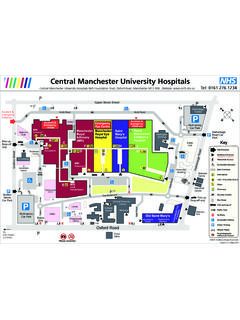Transcription of Gynaecology Service – Warrell Unit An operation for ...
1 Saint Mary's Hospital Gynaecology Service Warrell unit An operation for prolapse . laparoscopic sacrocolpopexy Information for Patients What is a prolapse ? A prolapse is a bulge or lump in the vagina caused by sagging of the vaginal walls. Why am I being offered this treatment? You are being offered a laparoscopic sacrocolpopexy operation as you have a prolapse which bothers you and treatment with a vaginal pessary has not been successful or has not been something that you previously wished to try. What is a laparoscopic sacrocolpopexy ? After a hysterectomy the top of the vagina, where the neck of the womb (cervix) used to be, is called the vault. The vaginal vault can sag down, known as a vault prolapse . A laparoscopic sacrocolpopexy operation involves supporting the vaginal vault using a piece of permanent artificial mesh material. One end of the mesh is sewn onto the vagina and the other is attached to the sacrum bone using titanium staples.
2 The operation is performed using keyhole surgery (laparoscopy), which means that you will have 2-3 small cuts on your tummy rather than one, larger cut. What are the benefits and how long will it work for? A laparoscopic sacrocolpopexy treats vault prolapse in approximately 90% of women (9 in 10). Often there is also some prolapse of other parts of the vagina and the operation is not quite as good at treating this. Overall, we have found 80% of women (8 in 10) are cured of their prolapse symptoms after the operation . Our tissues continue to stretch and give way over time. This can result in further prolapse developing. We have found that approximately 35% of women (1 in 3) have some prolapse that can be measured on examination 5 years after the operation . However, many of these women did not have any bothersome symptoms or need anything doing about it. 2. What are the alternative treatments?
3 The alternatives to laparoscopic sacrocolpopexy are: Do nothing: prolapse is not a dangerous or harmful condition. If it is not bothering you, you could decide to do nothing about it. If the prolapse is very large, we may suggest checking it is not stopping your bladder from emptying properly before you make your final decision not to have treatment. We would also suggest thinking about having your prolapse treated if it is rubbing on your underwear and getting sore. Vaginal Pessary: If you have not already tried a pessary, we would encourage you to do so. There is a large range of plastic pessaries available to support the prolapse . These are worn inside the vagina and, once in place, you should not be able to feel them. They are fitted by a nurse or doctor who will advise you on the type and size of pessary that might suit you best. We usually suggest you have the pessary changed every 6 months.
4 Some GP surgeries will change pessaries for you. Pessaries are good at treating the symptoms of prolapse . 70%. of women (7 in 10) who use a pessary find it successfully treats their symptoms. However, not everyone finds a pessary to suit them. The main disadvantage of a pessary is that it needs to be changed. Sometimes the pessary can rub the vaginal walls causing bleeding or discharge. This can be treated with some cream. A Different operation : There are many different operations used to treat prolapse . Deciding which operation to have depends on may factors including: The type of prolapse you have. What treatments you have had in the past. Any medical problems you may have. 3. It is not possible to list all the possible operations in this leaflet. If you decide you want a different operation for your prolapse , your doctor will explain the options open to you.
5 What will happen before the operation ? If you have not already done so, you will be asked to complete an electronic questionnaire to help us identify your troublesome symptoms. You will also be asked to fill in a bladder dairy to give us some information on how your bladder is working. Most women requesting a laparoscopic sacrocolpopexy will not need any other tests. However, if you are having a lot of problems with your bladder or bowels, the doctor may suggest extra bladder or bowel tests. They will explain why they have suggested the test, what it involves and give you a leaflet explaining them in more detail. Shortly before you come in for your operation , you will be asked to attend a pre-operative appointment with a nurse. It is important that we arrange this for you as it gives us an opportunity to make sure we can reduce your risk from surgery as much as possible.
6 It will not be possible to go ahead with your operation until these checks are done. Routine tests, such as blood tests and a heart tracing may be done at this appointment. You may need other tests depending on what medical problems you have. Please bring a list of all your medications, and any allergies you might have, with you when you attend. Before you come in to hospital for your operation , you should make sure you have a supply of simple pain relief, such as Paracetamol, as this will not be supplied for you to take home. 4. How is the operation performed? Before you go to theatre for your operation , you will be given some elasticated stockings to wear. These reduce the risk of a clot in the leg, known as a deep vein thrombosis (DVT). The operation is performed with a general (asleep) anaesthetic. The anaesthetist will discuss this with you. During the operation , a camera is inserted into your abdomen through a small cut near or in your tummy button (umbilicus).
7 The surgeon will also make 2 or 3 small cuts on your abdomen to pass instruments inside in order to perform the operation . To make a space to work in, your abdomen is filled with carbon dioxide gas. This gas sits in the space outside the intestine and is removed at the end of the operation . A strip of artificial mesh material is then stitched onto the vagina with dissolvable stitches before the other end is stapled to the sacrum bone. The mesh is then covered over with the lining of the abdomen known as the peritoneum. Once the gas has been let out, any cuts in the skin are closed with dissolvable stitches. The operation takes between 1 and 2 hours to complete. A dose of antibiotics will be given during the operation to reduce the risk of infection. A catheter tube is inserted along the urethra into your bladder during the operation and left in place until the following morning.
8 What will happen after the operation ? The catheter tube will be removed the morning after your operation . Most women find they only need simple pain relief such as Paracetamol. Once you are eating, drinking and passing urine normally, you will be able to go home. Most women go home the day after their laparoscopic sacrocolpopexy . We will give you some fibre powders to take home to help your bowels move without the need to strain. 5. What happens after I get home? It is normal to feel more tired than usual after an operation and this may last several weeks. It is important to take rest and allow your body to heal. However, we would advise gentle exercise, initially around the home, to help prevent a DVT. Try to avoid strenuous exercise that leaves you short of breath, heavy lifting or straining on the toilet as this can put a strain on the repair. You can drive as soon as you can make an emergency stop without it hurting.
9 This usually takes 4 weeks. If you work, you may need a certificate for your employer. This can be supplied (on request) before you go home from hospital. We would like to see you in the out-patient clinic 6 months after your operation to check it has healed well and see what effect it has had on your symptoms. We will ask you to repeat the electronic questionnaire as part of this follow up appointment. What are the risks of surgery for prolapse ? Unfortunately, all operations carry some risk. It is important that you are aware of these risks and consider them when making a decision whether or not to have surgery for your prolapse . There are some general risks that are present for any operation . These include: Anaesthetic Risks: The risk from having an anaesthetic is usually small unless you have certain medical problems. Bleeding: The risk of serious blood loss is very small and it is rare that we have to give a blood transfusion after prolapse operations .
10 However, your risk of bleeding may be higher if you are taking an anti-clotting medication, such as Warfarin. It is very important that you share with us any religious objection you may have to receiving blood in a life threatening emergency. 6. Infection: There is a risk of infection at the wound site or in your bladder, which is reduced by giving you a dose of antibiotics during the operation . The risk of a serious infection is very small. You will be screened for MRSA at your pre-operative check by taking some skin swabs. Deep Vein Thrombosis (DVT): This is a clot in the deep veins of the legs. The risk of a DVT is about 4 in 100 and many cause no symptoms. In a very small number of cases, bits of the clot can break off and get stuck in the lungs causing a serious condition (pulmonary embolism). The risk of a DVT is higher in women who smoke or who are overweight.






